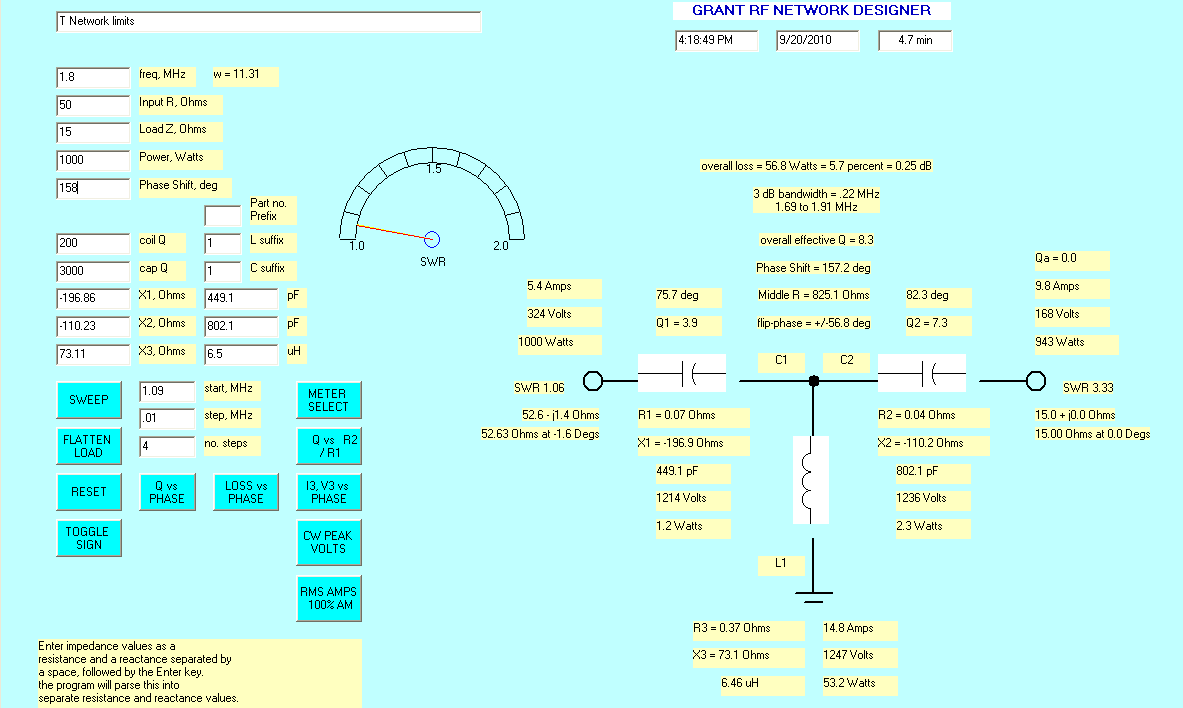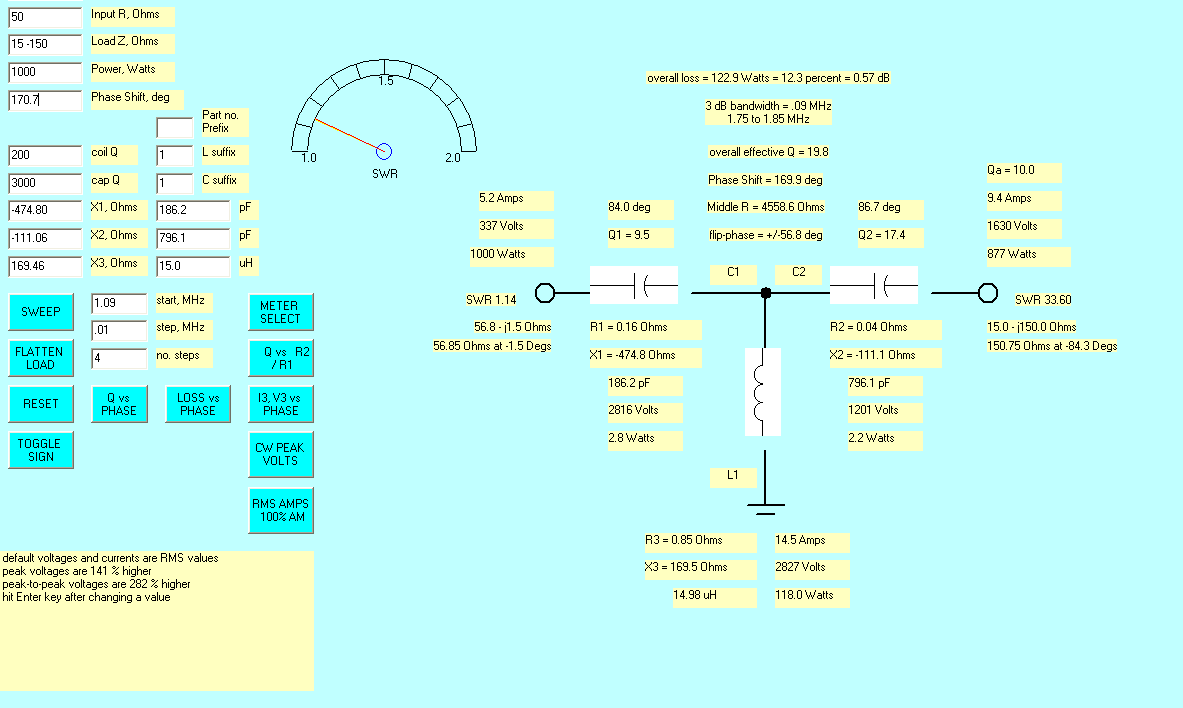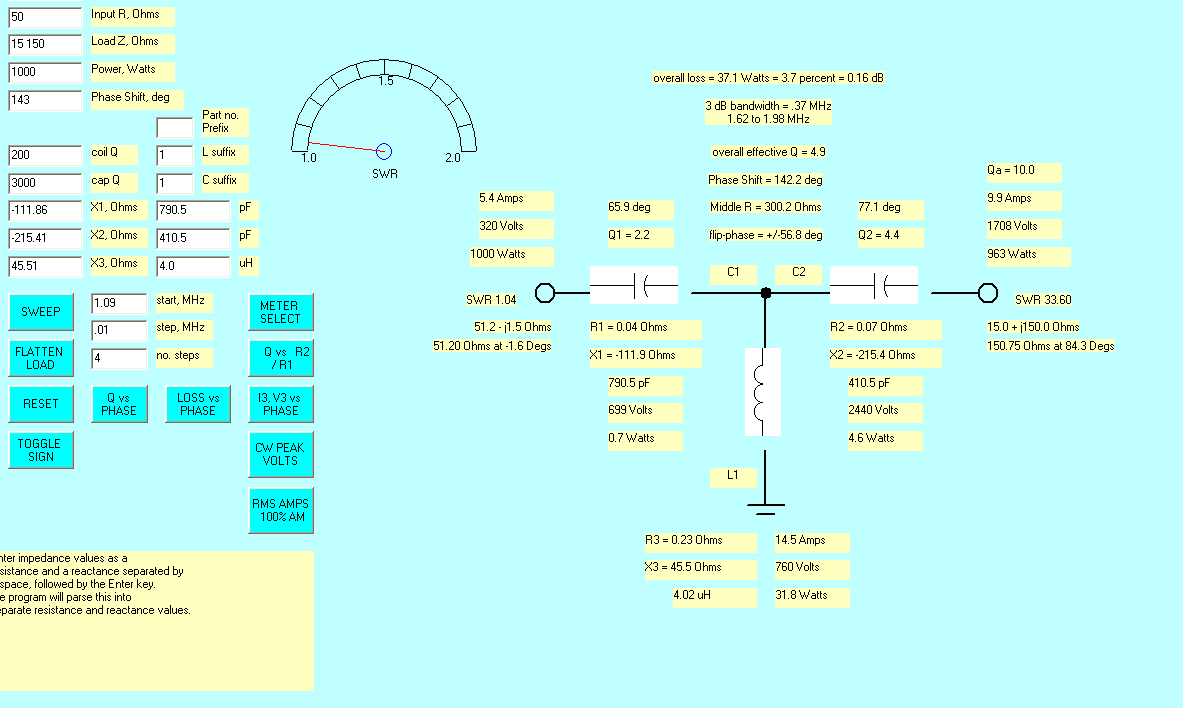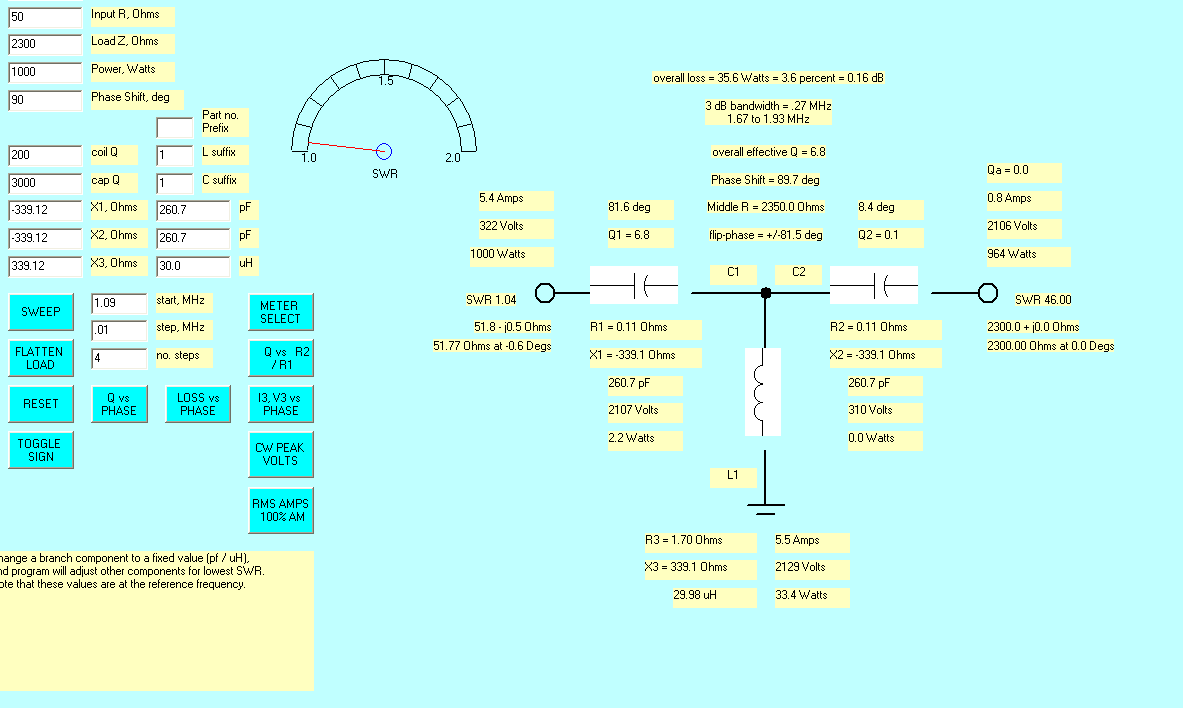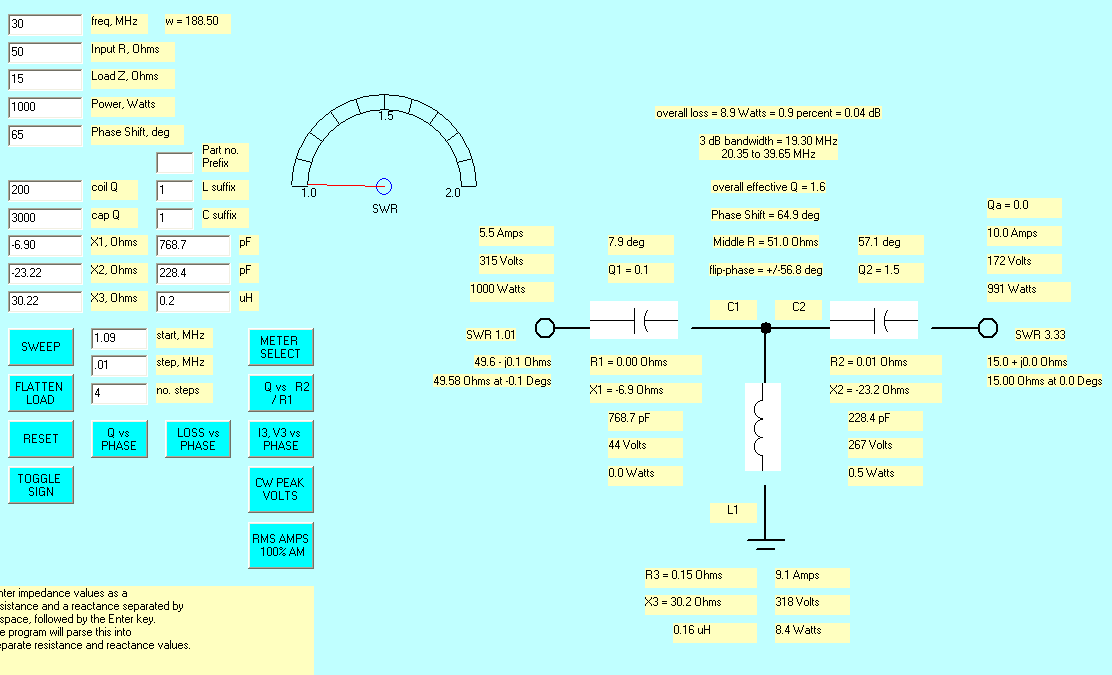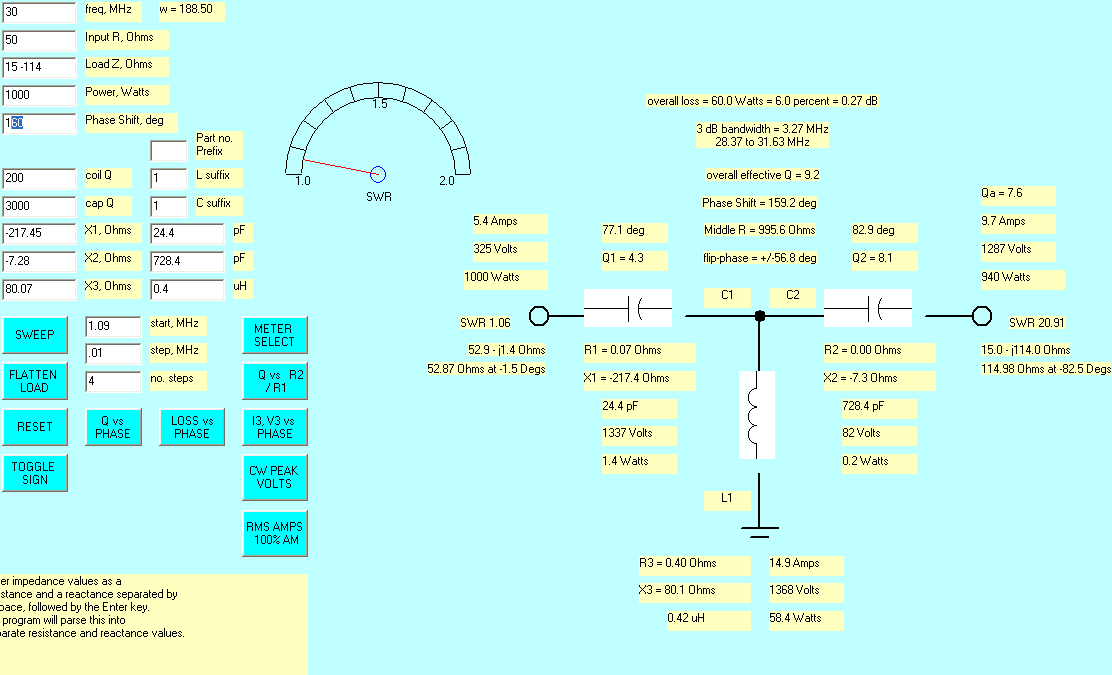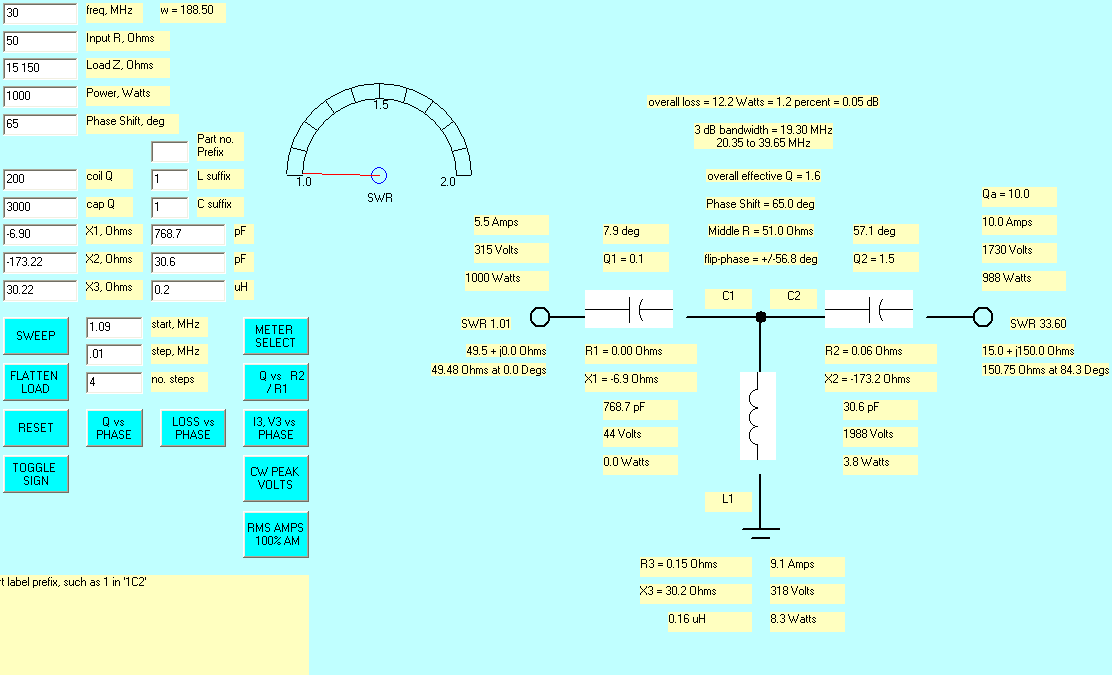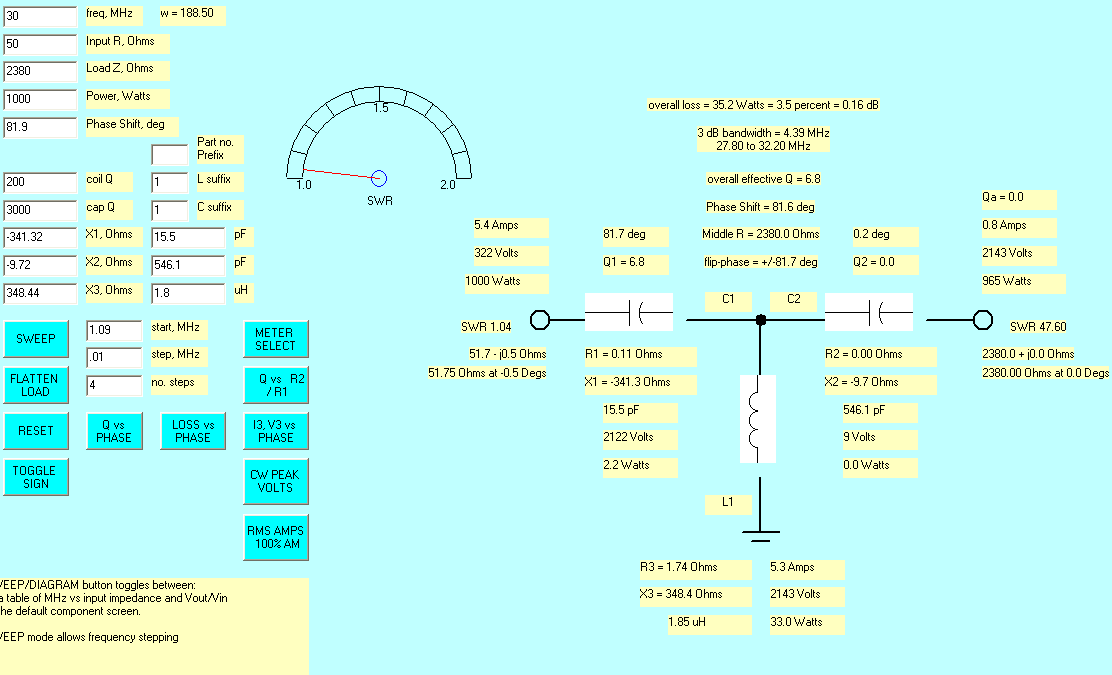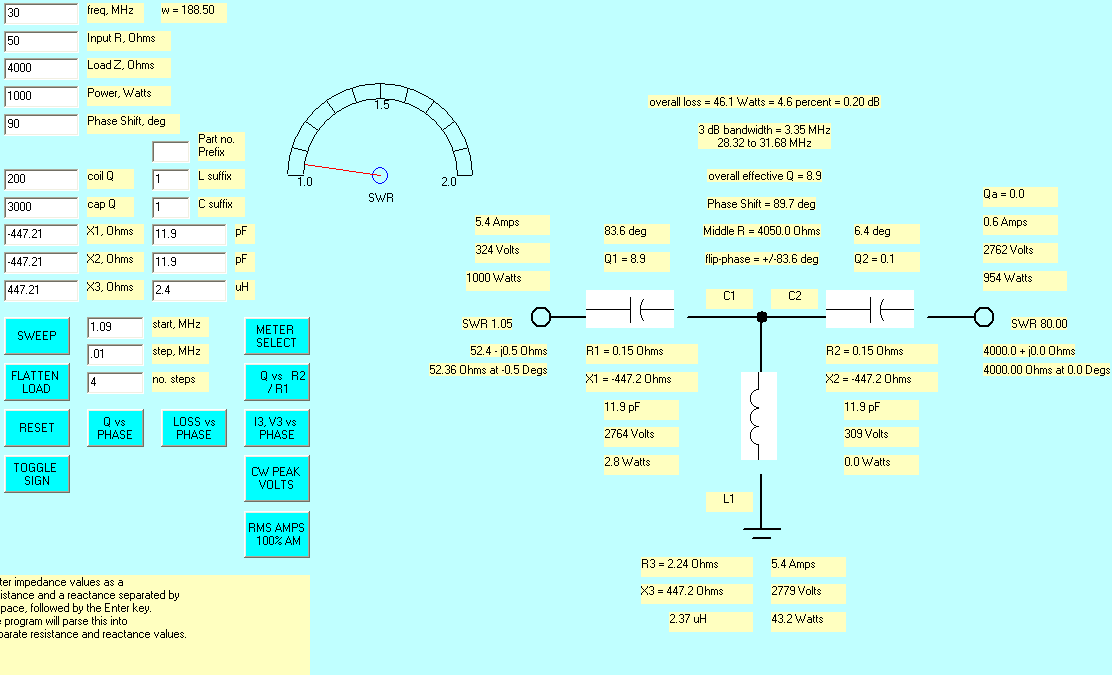EF johnson matchbox L network T network
Under Construction this under construction
ANTENNA TUNERS or Matching Networks
[ Home ] [ Up ]
EF Johnson Matchbox
The Johnson 275 watt and Kilowatt Matchboxes are
both unnecessarily exaggerated and unnecessarily maligned. They are not
exceptional tuners. They are not poor designs. The primary drawbacks are the
fixed coupling link, and the fact they are balanced VOLTAGE sources, not the
generally more ideal current source.
In the Johnson Matchbox, C1 is a standard dual-section
TUNING capacitor. C1 has a common dual area rotor, and a split stator.
C2 is special and expensive. C2 is a dual-differential MATCHING capacitor
with four capacitor sections. C2 has two insulated rotor areas in differential
tied to the balanced outputs, two independent stators, and two
commonly-connected stators.
C2 is overcomplicated, with unnecessary sections
in C2. The unnecessary sections of C2 are the two sections connected to ground.
The two unnecessary grounded sections neither benefit nor harm tuner performance
significantly. The tuner works almost identically when grounded inner sections of
MATCHING capacitor C2 are eliminated.
The fact Johnson included unnecessary grounded
sections of C2 does not make it a bad tuner. The inclusion of unnecessary
(basically harmless) sections only means Johnson wasted money and space inside
the tuner by including the nearly-useless grounded C2 MATCHING capacitor sections.
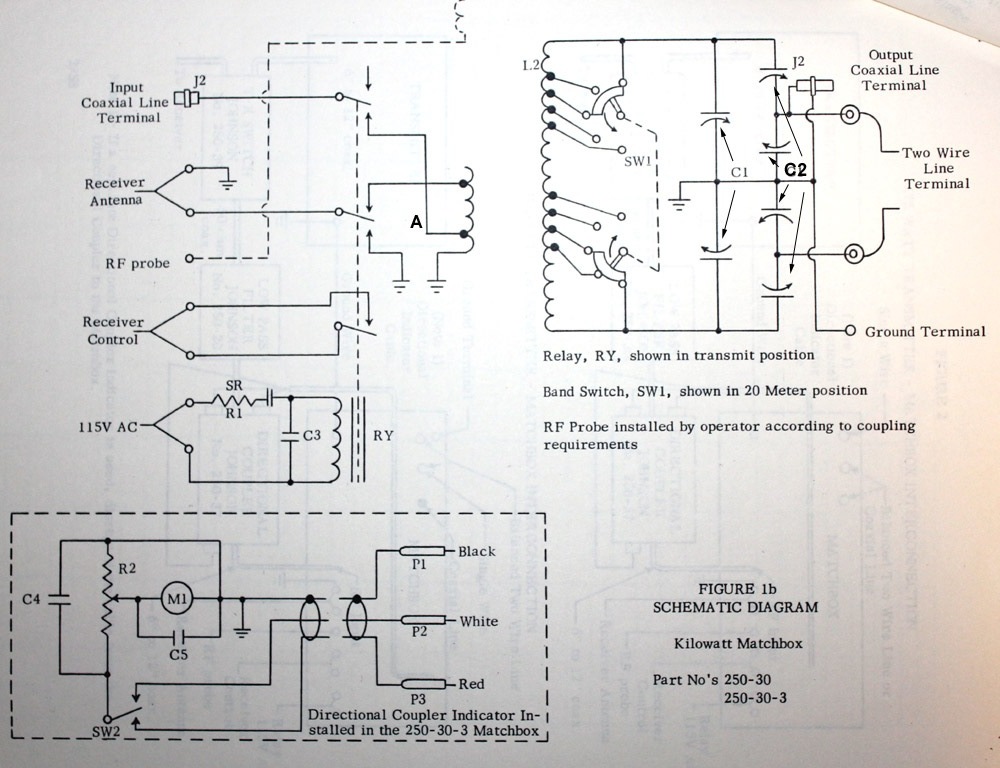
In the 1980’s, I designed an
Ameritron ATR-10 antenna tuner (not related to any current Ameritron products).
The ATR10 Ameritron was a companion to the AL84, and was designed as a companion bandpass 600-watt antenna tuner. The Ameritron ATR10 antenna tuner used a
network functionally identical to the Johnson Matchbox series. The ATR-10 was a single-ended
tuner with an output
balun. The ATR-10 used a tapped inductor instead of a coupling link. The basic simplified ATR10 antenna tuner matching
circuit is shown below:
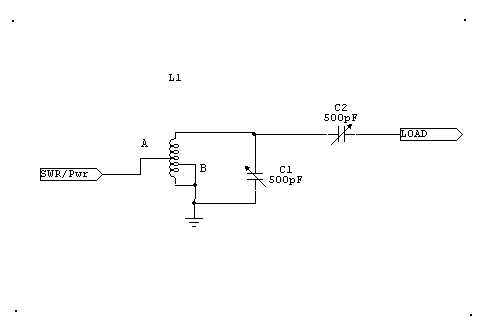
Tap A is from a standard rotary switch contact.
This tap always leads tap B toward the hot end of the tank. The amount of lead
controls tank Q. Tank Q determines matching range and power rating, just as
changing turns controls Q and range in any link coupled tuner.
Tap B is the band selector tap. This switch is a
progressively-shorting (pick-up-and-hold) contact. Tap B determines inductance,
which in turn sets frequency range.
If we ignore the nearly useless grounded sections
of C2 in the Johnson Matchbox, and understand a link is not much different
electrically from the tap on the ATR10 Ameritron, we see the ATR10 and EFJ
Matchbox are electrically identical in matching function.
I dispensed with the needless shunt capacitor on
the output in my ATR10 design.
The Ameritron ATR10 and E.F. Johnson Matchbox tuners both use
a combination series and parallel resonant output circuit. This circuit actually
forms a T network. If we assume C2 is
set to resonance and C1 has zero capacitance, we have a classic link coupled series tuned network
with low output impedance. If C2 is set to a high capacitance value, and C1 is tuned to
resonance, we have a classic parallel tuned network. In both cases the tap-point A
distance above band-point B sets maximum impedance ratio, because the tap point
determines maximum operating Q and available voltage at the common junction of
L1 top, C1, and C2.
C1 primarily determines load resistance value,
while C2 primarily compensates reactance. Ironically, Johnson calls C2 Match and
C1 Tune! Lowest impedance is with C1 open and C2 tuned to correct resonance.
Impedance increases as C1 is moved closed, with C2 progressively closed. Highest
impedance is with C2 fully closed and C1 tuned to resonance.
If we are mindful of how the ATR10 works, we will
also understand the more complex Johnson Matchbox. In the case of the Matchbox
series, the number of turns on the LINK coil sets matching range and maximum
power capability of the tuner.
- With fewer turns on the E.F. Johnson tuner link compared
to turns on L2, the system has higher voltages and wider matching range.
This reduces power rating, but increases match range and selectivity.
- With more turns on the E.F. Johnson’s link compared to
turns on L2, the system has lower voltages and wider matching range. This
increases power rating, but decreases match range and selectivity.
The EF Johnson, unlike the ATR10, does not
maintain the same primary-to-secondary ratio as bands are changed. The Johnson
KW and 275 watt Matchbox tuners have widest matching range and highest Q, and
lowest power rating, on lower bands. Conversely, the Johnson tuner has narrowest
match range and lowest Q, and highest power rating, on upper bands. This is the
result of using a fixed number of link turns, while varying L2 turns
significantly.
My solution to this issue in the EFJ tuner is to
make extra taps available as a transmit option, and slightly modify the tap
positions. This provides external selection of Q and match range. To
accomplish this, I installed an extra pair of connectors. Other options would be
an additional internal switch, or the addition of a
suitable series capacitor on the link.
This type of network, unless we can vary the
link, has a limited matching range.
Actual dipole and tuner
measurements link
Component Q
Spacing inductors away from sheet metal.
A typical #14 or 16 gauge B&W Airdux or Miniductor coil might have a Q of 300
in open air, and that Q might drop to 260 or so with sheet metal near the axis.
Here are some actual measurements of a small 3″ diameter air core coil. This
particular coil uses fairly thin wire and is not of optimum form factor, so basic open-air Q is
only around 160. The following measurements are with the coil axis spaced around
1/4-inch from a large flat metal sheet. This coil is from a MFJ 300 watt tuner.
Measurements are on 2 MHz. Measurements are made on an HP4191A impedance test
set (the industry standard for measuring or characterizing components):
Air for several inches around the coil = 160
Aluminum = 150
Copper = 152
steel = 142
stainless steel = 70
nichrome sheet= 62
We can see some materials greatly decrease Q, but most materials of
reasonable or good conductivity have little overall effect on Q.
Roller Inductor Q
The following data was supplied by G3TXQ Steve. When I enter
my data in a spread sheet, I will post it also. The trend of Steve’s data agrees
with my measurements, although there are differences in data because I measured
different inductors. I measured less peak Q, but also significantly higher
minimum Q in the inductors I tested. While the inductors I measured has less
delta in Q, they also had a serious dip in Q up near 25-35 MHz when near
half-inductance. This is because of series resonances.
Notice that shorted turns do NOT have the drastic effect
sometimes predicted in amateur articles. For example, look at the 160 meter Q.
It actually peaks with some turns shorted!
Do not worry about shorted turns reducing Q in a normal
air-core inductor. There are cases where Q can be significantly reduced, but they
are not common cases. In many cases shorting unused turns can increase
Q. I will post measurements of shorted turns and Q as I
measure new design projects.
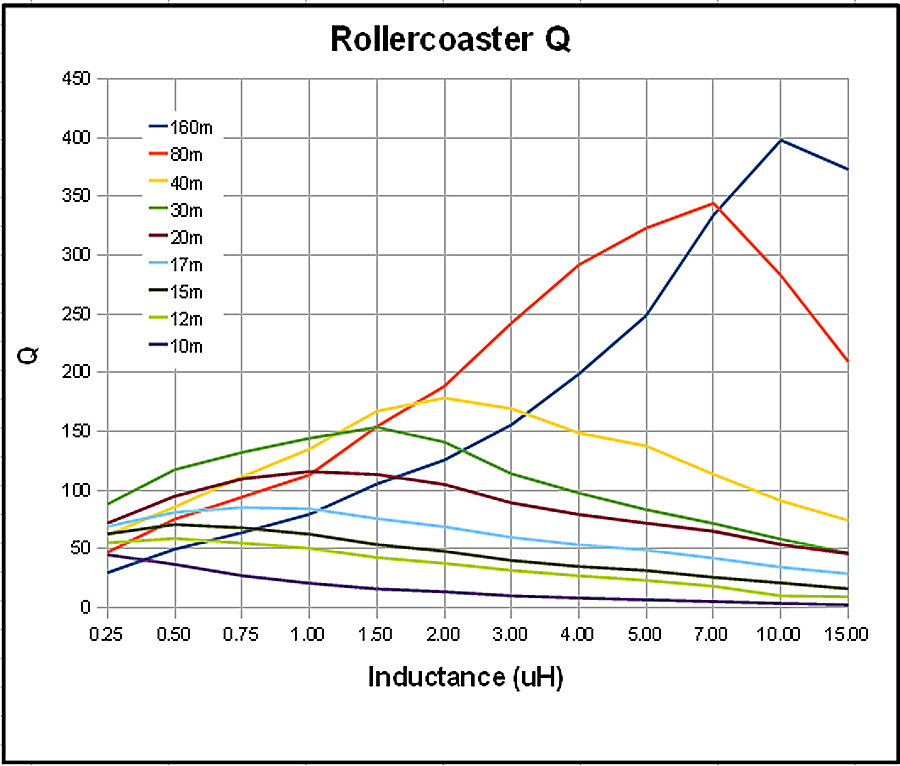
Roller Inductor series resonance:
The sweep below, taken on an 8753C vector network
analyzer, shows roller to chassis terminal impedance from a floating roller’s
frame. The cyclic impedance pattern below is indicative of series resonances,
which also reduce roller Q. This would go away if the roller was “shorted” at
multiple points in the unused areas of the roller, but such designs are
difficult at best.
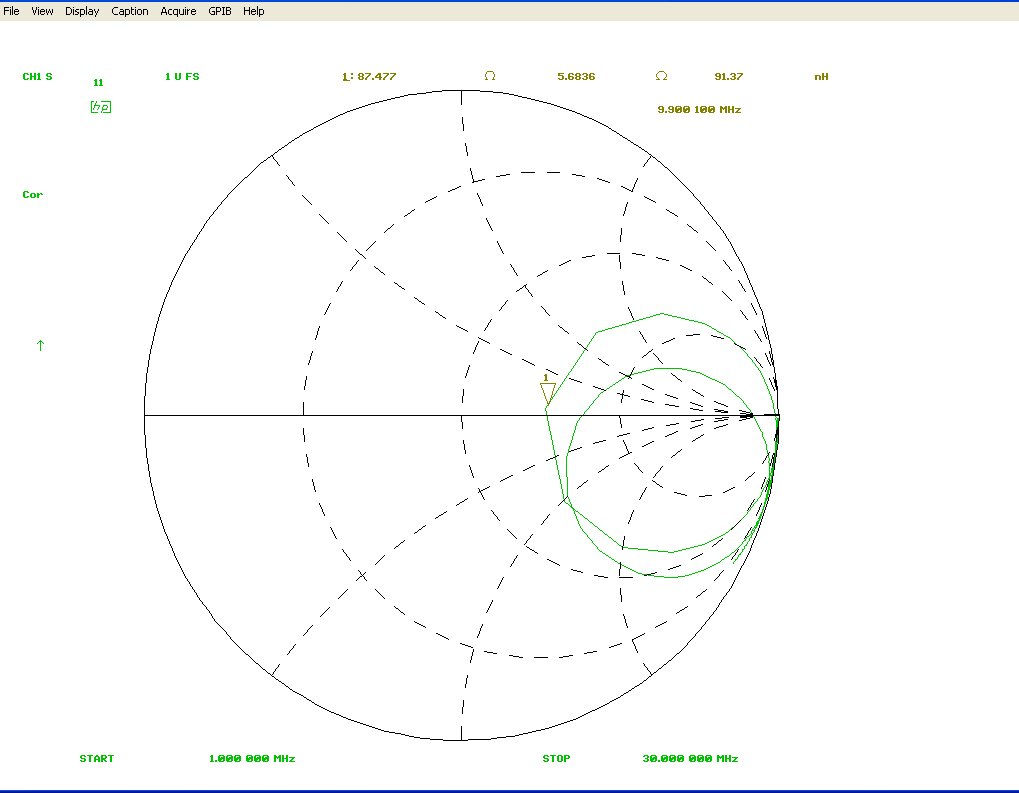
T-network vs. L-network
One endless argument is which network is better, a T-network
or an L-network. This argument goes on continuously because each network has
advantages and disadvantages, while in actual fact loss differences are really
fairly small.
If we budget similar amounts of money, the L-network generally has a little less loss.
The saving grace of the L-network is it just won’t match a bad load impedance.
The L-network “self-protects”, and generally won’t match loads that greatly
increase network heating.
The T-network has much wider matching range! The T-network also requires
less switching and fewer components.
L-Network = capacitance 15-2700 pF (Q=3000 overly optimistic at high
capacitance), inductance .1 to 30
µH (Q=200).
Note:
I’m working to correct the Q’s and make them more realistic.
T-Network = capacitance 10-800 pF (Q=3000), inductance 30
µH (Q=200).
The L-network’s capacitor must vary from 15 pF all the way
up to 2700 pF, and at one kilowatt the capacitor has to be over 2000 volts rating if the tuner is going to feed high impedance loads.
This means we either use a large vacuum capacitor, or the design must switch
various fixed capacitors in parallel with a lower-capacitance high-voltage
variable capacitor.
The Q for the T-network is probably pretty close to normal values except for
low inductance values.
The Q for the L-network is far too high for fixed capacitors (should be
around 1000 or less), and too high for the inductor across the range (way too
high at low inductance).
| Frequency | Load impedance | loss L | Loss T |
| 1.8 MHz |
15 -j150 | .38dB | .57 dB |
| 15 j0 | .03 dB | .25 dB | |
| 15 j150 | can’t match above 15 +j22 | .16 dB | |
| 15 j22.9 | limit of L network | ||
| 2380 j0 | .13 dB | .16 dB | |
| 4000 | can’t match above 2380 j0 | .20 dB | |
| 30 MHz | 8 j0 | .04 dB | need to run |
| 15j0 | need to run | .04 dB | |
| 2380 | .13 dB | .16 dB | |
| 4000 | can’t match | .2 dB |
Note, green lines are corrected Q=200 L network.
L-networks have a very wide range of impedances they just will
not match, and they require extraordinarily high values of capacitance to do
what they can do. To approach a T-network in matching range, they would require
switching the network into four possible configurations plus the extraordinarily
large values of capacitance. Because of these restrictions, L-networks have
limited utility on a 1.8-30 MHz all purpose tuner. L-networks are great for
matching known load impedances on a single band, but are cumbersome and expense
to properly implement in a wide range general matching network application. If
you are lucky with load impedances, you will swear by them. If you are not
lucky, you will swear at them because they just won’t match things a cheaper
poorer quality T network will easily match.
Varying Network Q
Loaded or operating Q is important in any
impedance matching network. Loaded Q is the actual working Q, not the individual
component “static” Q or “quality”. For example if we have a capacitor with a Q
of 3000 and a reactance of 3000 ohms, it has a series resistance of 1 ohm (or a
shunt resistance of 9-megohms). This is quite possible in an air variable
capacitor, but few small ceramic single layer capacitors produce such high Q’s.
If we shunt that capacitor across a load of 300 ohms, the loaded Q becomes just
slightly less than 10.
Phase shift and network loaded or operating Q are closely related. The greater Q
for a given impedance transformation ratio, the greater network phase shift
becomes. The table
below assumes a 1:1 impedance ratio. Q will be higher for larger impedance
ratios.
A common rumor is there is only one optimum setting for
maximum efficiency in a T-network. Let’s look at some numbers using realistic “amateur product”
Q values of 200 in the inductor and 3000 in the capacitors. This produces
numbers where a rule of thumb works. With 1000 watts in, the loss in watts is
approximately equal to phase shift up to 90 degrees!!! The loss table for 1000
watts applied, when matching 50-ohms to 50-ohms, would be:
| Phase shift | Q | Power loss out of 1000 Watts |
| 0 deg | 0 | 0 loss |
| 5 deg | 0.1 | .5 watts loss |
| 20 deg | 0.2 | 2 watts loss |
| 40 deg | 0.5 | 4 watts loss |
| 90 deg | 1.4 | 10.6 watts loss |
| 130 deg | 3 | 22 watts (only 0.1 dB loss) |
| 140 deg | 3.9 | 29 watts (-0.13 dB) |
| 150 deg | 5.3 | 38.3 watts (-0.17 dB) |
| 160 deg | 8.0 | 57 watts (-0.26 dB) |
| 170 deg | 16.2 | 109 watts (-0.5 dB) |
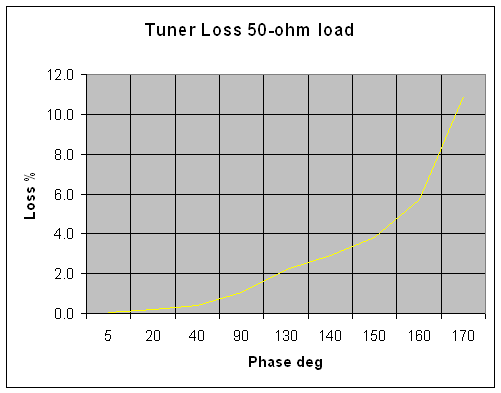
From 0 degrees to 130 degrees phase shift, a T-network with
modest Q components has less than 0.1 dB
loss!
The real problem with loss is power handling, not signal loss.
We need to be very careful where a few watts of loss occurs, because even
a few watts can heat something very small to a high temperature. We would like
loss to be spread out over a wide area in physically large components so the
heat “gets out”. Most of the time it is, but unfortunately some of the time it
is not. Careful tuning will minimize potential problems.
Proper Way to Adjust a T-network Tuner
There is little change in efficiency or performance over
a wide range of Q’s. This is because loss is very low, so even doubling loss
makes very little difference in power. Doubling loss will of course double heat,
but the larger problem is the
increase in capacitor voltages. Arcing can cause a tuner to fail even while loss
in signal level is totally undetectable at the other end of a QSO. Arcing is a
fast failure and very destructive, because it produces localized heating.
Besides increasing voltages and heat, increasing Q
also decreases bandwidth. This means a tuner requires more frequent retuning when operating
frequency is changed within a band.
In order to minimize the need to retune and maximize the
power rating of a tuner, it is necessary to tune or match with the minimum possible
operating Q. In a T-network, we want minimum inductance and somewhere around the
maximum possible capacitance that allows a good match. The quickest way to
damage a switch or capacitor in a tuner is to adjust the tuner with too much
inductance.
The worse advice, when tuning a T network tuner, is to start
with the capacitor mid-way and adjust the inductor for maximum noise or minimum
SWR. On lower bands the capacitors should be set to maximum capacitance as a
starting point. Normally halfway open is a good place for the higher bands,
typically 15 meters and higher in a 160-10 meter tuner.
160-80 meters=fully meshed
60-20 meters=3/4 meshed
20-10 meters=1/2 meshed
Matching Range
L-Network with maximum C of 2700 pF, and maximum L of 30
µH.
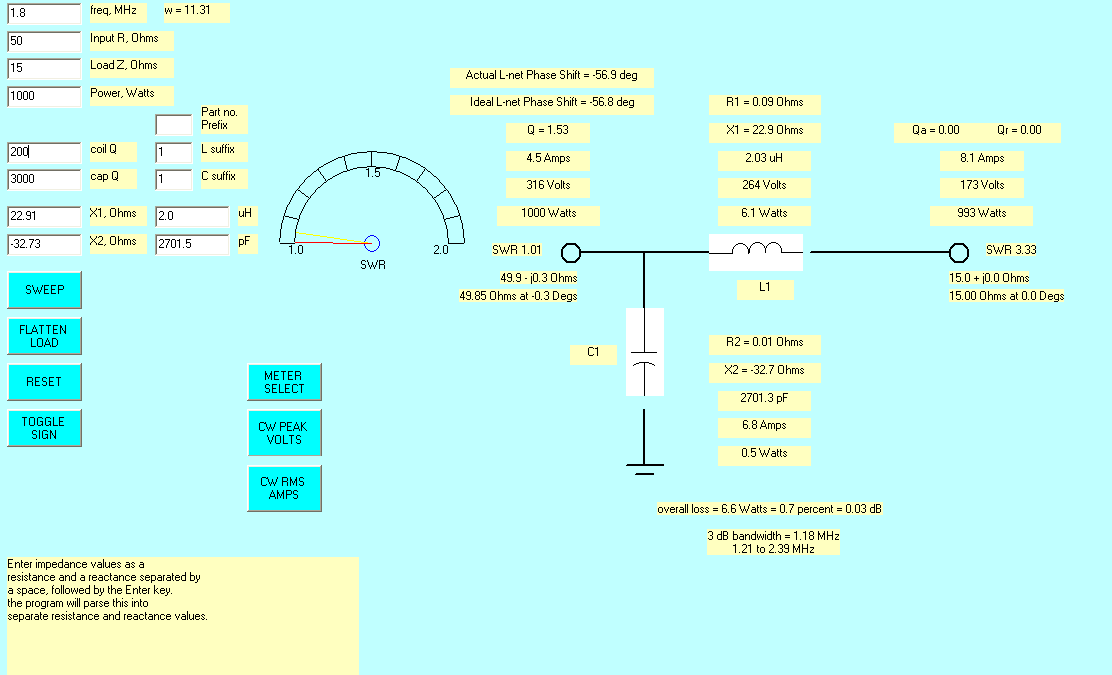
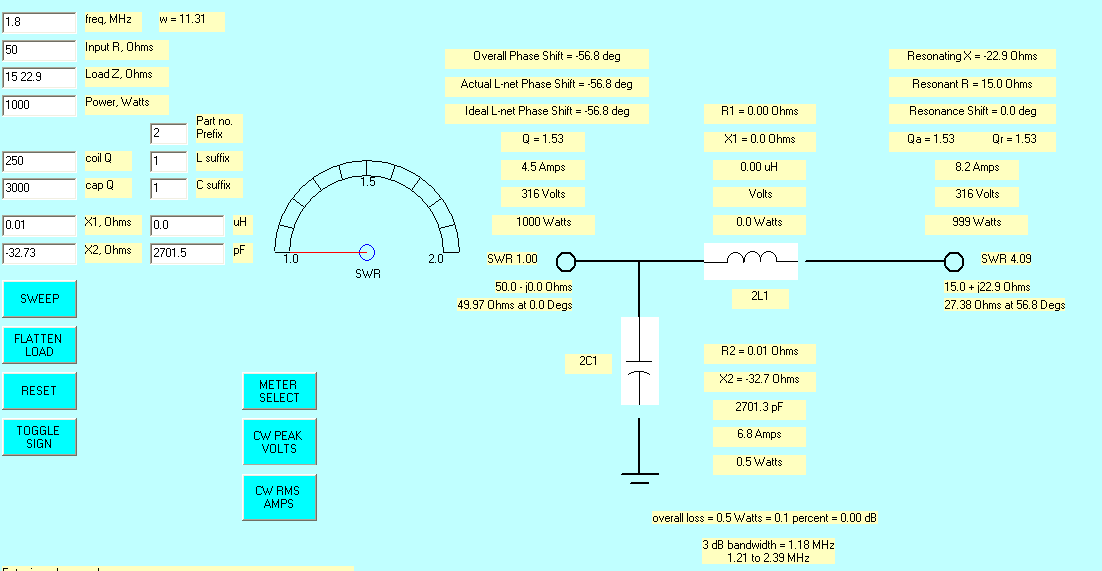
This is the lower impedance limit of an L network with 2700 pF of capacitance. It
will not match any positive (inductive) reactance above 22.9 ohms on 1.8 MHz.
This narrow matching range, even with large values of
components, is one drawback of an L network.
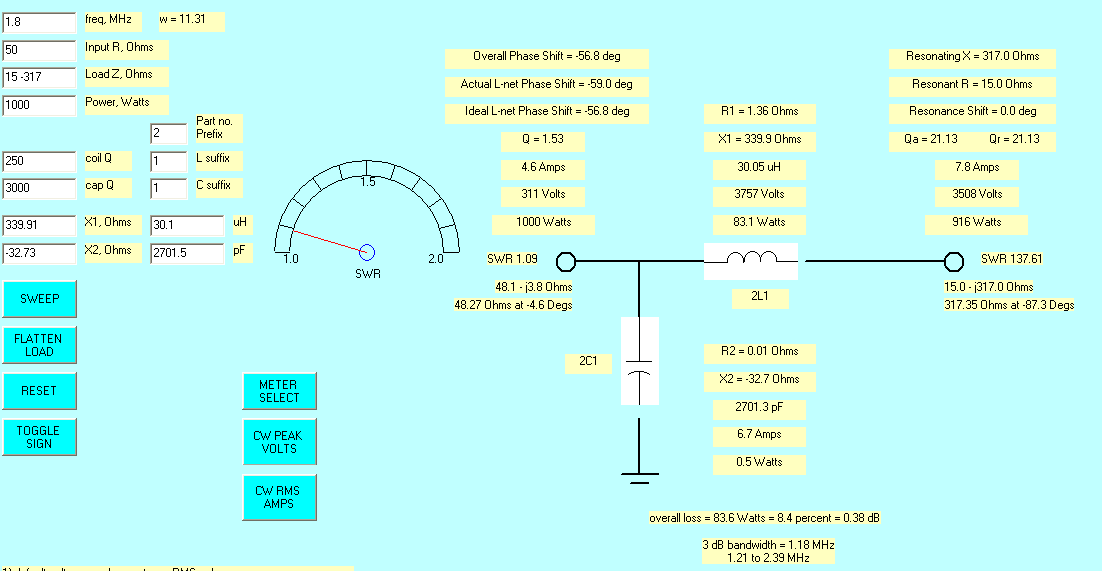
This is the maximum capacitive load that can be matched at 15 ohms resistive. At 15 -j317
the network is
out of inductance.
The L network has poor matching range for low impedance loads, and requires a
very large capacitor for 1.8 MHz.
Like the T network, loss is reduced with inductive loads.
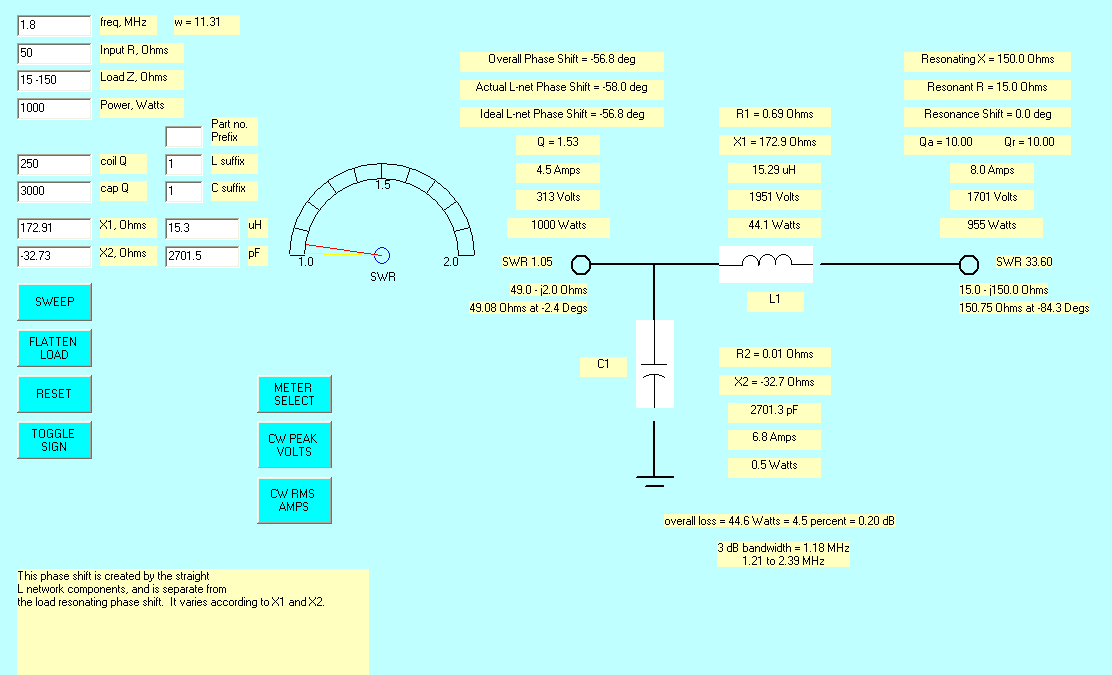
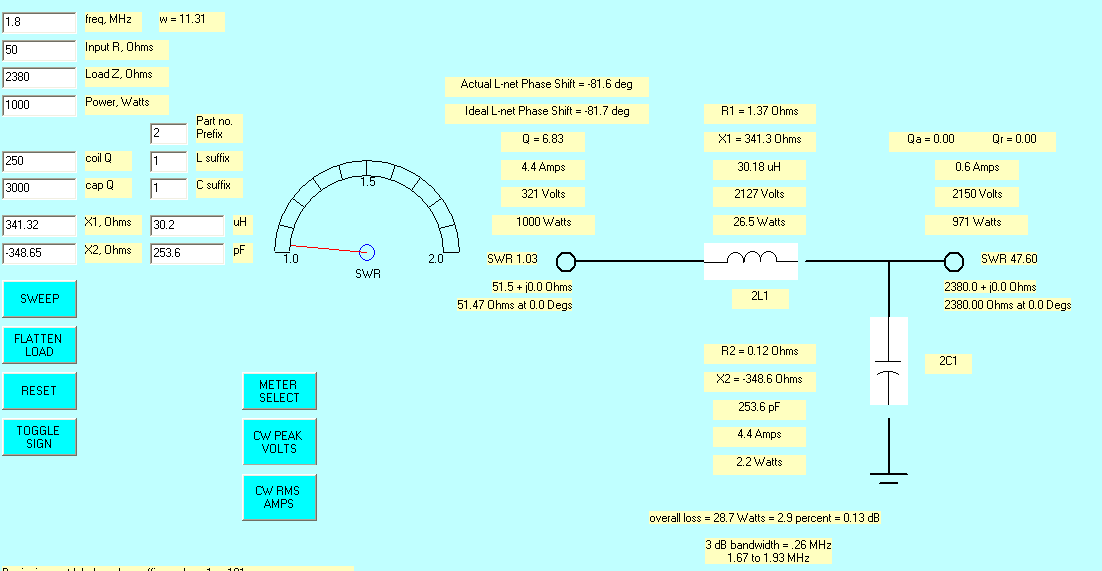
The L network has a good reactance range if we lower the resistance down from
maximum, but the capacitor and switch must be able to handle 2150 volts at 1000
watts.
Note we had to reverse the network.
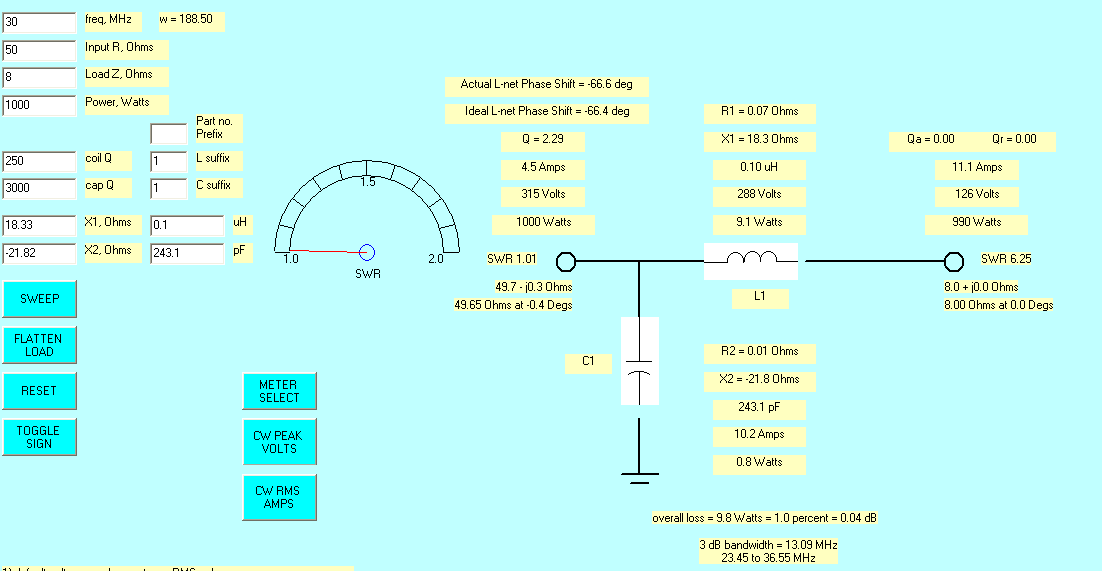
The low Z limit on ten meters is set by the stray inductance.
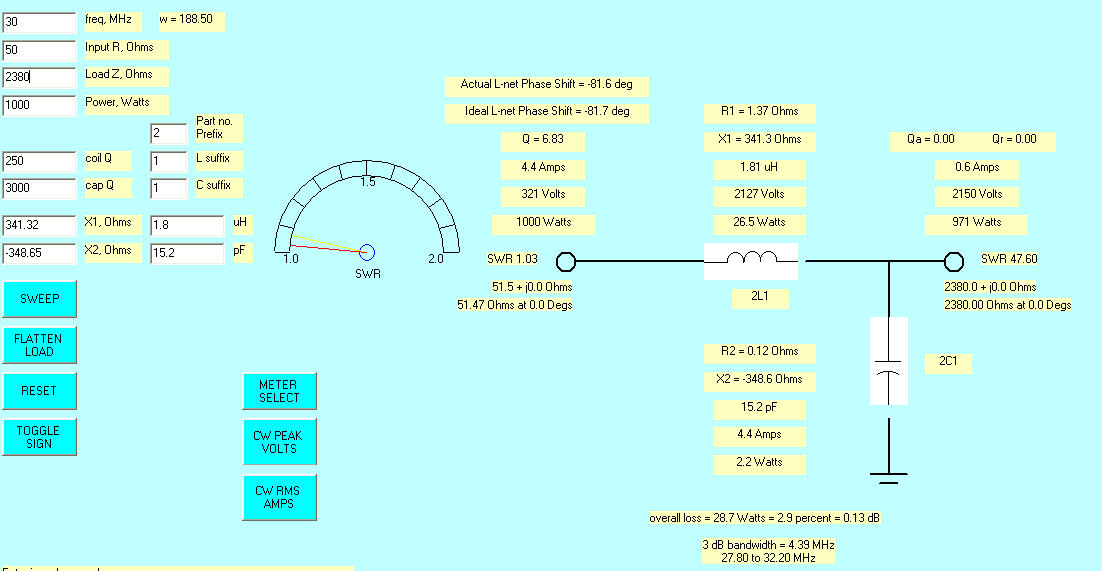
Ten meters with high impedance limit.
The high Z limit on ten meters is set by stray capacitance.
